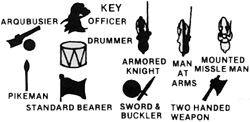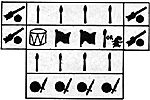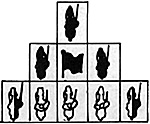 Historical wargaming is replete with periods which
capture the popular imagination. The period of the
Napoleonic wars and the Ancient era are the most popular
today. There is another period, however, which easily rivals
these two giants, the Renaissance, a period vibrant with
transition, experimentation, a multitude of tactical doctrine,
weapons, color and personalities. The period covers
history's tempestuous struggles, such as the Valois-
Habsburg wars in Italy and more esoteric campaigns, such
as Yamada Nagamasa and his Ronin army's victory over
the Spanish in Siam in the 1600's.
Historical wargaming is replete with periods which
capture the popular imagination. The period of the
Napoleonic wars and the Ancient era are the most popular
today. There is another period, however, which easily rivals
these two giants, the Renaissance, a period vibrant with
transition, experimentation, a multitude of tactical doctrine,
weapons, color and personalities. The period covers
history's tempestuous struggles, such as the Valois-
Habsburg wars in Italy and more esoteric campaigns, such
as Yamada Nagamasa and his Ronin army's victory over
the Spanish in Siam in the 1600's.
However, there is a dearth of information on just how to begin simulating in miniature the conflicts of this era. This article does not intend to be the final arbiter in the period, nor a general history outline. Rather, it is my intention to introduce the basic elements needed to encourage interest in a period heretofore generally ignored on this side of the Atlantic.
FIGURES AND SCALE
Perhaps the greatest dilemma facing the wargamer who has decided to game in the Renaissance period is the choice of scale between 15mm and 25mm figures.
The 15mm figure offers economy both financially ancl in the amount of time consumed painting and preparing the figures. One can argue, favorably, that the diminutiveness of the 15mm casting allows one greater scope in recreating entire battles, or equally to expand the parameters of the game to allow striking flanking movements. For most players of long standing, however, the 25mm figure still maintains sovreignty on the gaming table. Hinchcliffe, Mini-fig, Ral Partha all carry a prodigious range of Renaissance figures. These castings range in quality from very good to extraordinary, and when placed on the table, painted, terrained, and arranged in historical units, display a grandeur that overshadows such colorful "costume" periods as Napoleonics or Ancients. In addition, they are on a par with the Ancient period in categories such as weapons types and army list variety.
However, the gamer who is convinced that 25mm figures are the scale in which he wishes to work soon realizes the twin complaints, "I haven't the time to paint an army" and "I don't have a small fortune to invest." This is beside the point that gamers soon lose enthusiasm for a project that is too drawn-out.
The answer, then, would be a group project, one in which several, if not all, the members of the club contribute a small portion to make up the whole. This has several advantages: it saves time and money, allows one the pleasure of indulging in periods that would otherwise be "closed", allows time for research (a point all too often ignored), separates the enthusiasts in the club from the loafers, and permits the indulgence to paint showier" figures. For the lone wargamer, or for the one who finds himself the cultist in a club of troll die-rollers, I recommend without hesitation the 15mm Minifig Renaissance range.
Assuming one belongs to one of the more enlightened organizations, the question now is how does one begin. First let me state that here we are discussing the core of the Renaissance period, that is, the late 15th to middle 16th centuries. The later 'musket and pike' period, dominated by the Thirty Years War and the English Civil War would be another article unto itself.
THE BASIC UNIT -- THE COMPANY
The simplest way to approach Renaissance wargaming as a club project, is for each person to contribute one or more units. The tactical units differed from country to country, but remained basically the "Company". In its Western form, this was meant to represent an integral unit of some four-hundred men, of which one hundred would be Dopplesoldner wielding special weapons.
Each of these companies were further divided into smaller units called rotten or files. It is with the Company, however, that we are primarily concerned, and this will be our basic integral unit. Next we must consider the ratio of figures to soldiers represented in each "Company". Unless there is someone within the club who has written an accepted set of rules with its own dictates as to ratio, I would suggest the universal scale of one casting representing twenty actual men.
This will at least keep you in good standing with fellow gamers at local and national conventions. If one assumes, as I do, that the scale is merely a gaming convenience, and that the number of figures represents a proportional abstraction of an entire army, then there is no nagging feeling that, at one-to-twenty scale, you are constantly fighting "advanced guard actions."
Having established the ratio we must now consider the actual organization of our tactical unit. If we take the median of our period, we have a multi-weapon unit consisting of pikemen, halbadiers and arquebusiers, in the Turkish, Spanish and Burgundian units adding swordsmen and possibly archers.
As was stated previously, our unit represents 400 actual men, on a ratio of 1:20, giving us a twenty figure unit. Add to this a figure to represent the staff. Of these twenty figures, anywhere from one-quarter to one-half represents double pay men, wielding two-handed or missile weapons. As our Company is a representative of the 1520-30s period, we have a higher proportion of arquebusiers than an earlier Company of, say, the Swabian Wars.
The organization chart shows the various compositions of Imperial, Swiss and Spanish companies Notice the Spanish have a lower proportion of pikes, but include the famous swordsmen. On the other hand, the Swiss, in advocation of their style of shock warfare, have a higher proportion of halbadiers and fewer missilemen. For those wishing to simulate the Turks, the best way to begin (indeed, given their fame and panache, the only way) is to paint and assemble a Jannissary Orta.
As this varied in strength from 100 to 500 men, it would be out of place to put them on the same 400 man basis as their Western counterparts. Again, the organization chart shows the structure of the unit. These then form the basis for any club effort to begin in the Renaissance. With perhaps three people per side each painting only 42 figures (two units), you have the respectable beginnings of two armies for very little effort. For the more outlying nations, the individualist should follow this rule of thumb: Twenty figures per unit half bow, or handgun; half bill or pike. When determining the proportion of artillery, one crewman per company painted is a good ratio.
 Next for consideration comes cavalry. This is again,
solved by each player contributing a portion of horsemen
Two knights or Spahi's of the Porte to three light or
medium missile-armed cavalry is a good proportion.
The organization chart shows a Burgundian Compagnie
d'Ordennance, which formed the basis for all Western
cavalry units.
Next for consideration comes cavalry. This is again,
solved by each player contributing a portion of horsemen
Two knights or Spahi's of the Porte to three light or
medium missile-armed cavalry is a good proportion.
The organization chart shows a Burgundian Compagnie
d'Ordennance, which formed the basis for all Western
cavalry units.
 Figure A. Swiss Company. The
organization of a Swiss company or 'double-company"
(some sources indicate approximately 200 men). The main
strength is derived from shock weapons; pikes and
halbreds. Organized on eight stands, on 15mm or 20mm
frontage. Total complement: two arquebusiers, twelve pike,
six halberd and one officer optional. For earlier periods, i.e.,
Burgundian and Swabian Wars, substitute crossbows or
handguns for arquebus. Fon later wars, substitute
arquebusiers for halberdiers (on 20mm frontage).
Figure A. Swiss Company. The
organization of a Swiss company or 'double-company"
(some sources indicate approximately 200 men). The main
strength is derived from shock weapons; pikes and
halbreds. Organized on eight stands, on 15mm or 20mm
frontage. Total complement: two arquebusiers, twelve pike,
six halberd and one officer optional. For earlier periods, i.e.,
Burgundian and Swabian Wars, substitute crossbows or
handguns for arquebus. Fon later wars, substitute
arquebusiers for halberdiers (on 20mm frontage).
 Figure B. Landsknecht Company. A more
halanced force: four arquebusiers, four halberdiers and
twelve pikemen, officer optional. In earlier wars, substitute
crossbows or handguns, or, alternately, organize like the
Swiss. In later periods, substitute halbards for arquebus
and/or musket (on 15mm or 20mm frontage).
Figure B. Landsknecht Company. A more
halanced force: four arquebusiers, four halberdiers and
twelve pikemen, officer optional. In earlier wars, substitute
crossbows or handguns, or, alternately, organize like the
Swiss. In later periods, substitute halbards for arquebus
and/or musket (on 15mm or 20mm frontage).
 Figure C. Spanish Colunela. Somewhat
understrength. Similar to the Landsknecht company,
except in the substitution of sword and buckler men for
halberdiers. A total of twelve pikemen, four sword & buckler
men, four arquebusiers. In early Italian wars, substitute
two pikemen for crossbowmen and two pikemen for sword
and buckler men. In later wars, substitute swordsmen for
arquebusiers and/or musketeers (on 15mm or 20mm
frontage).
Figure C. Spanish Colunela. Somewhat
understrength. Similar to the Landsknecht company,
except in the substitution of sword and buckler men for
halberdiers. A total of twelve pikemen, four sword & buckler
men, four arquebusiers. In early Italian wars, substitute
two pikemen for crossbowmen and two pikemen for sword
and buckler men. In later wars, substitute swordsmen for
arquebusiers and/or musketeers (on 15mm or 20mm
frontage).
 Figure D. Turkish Jannisary Orta. Almost
exclusively firepower oriented. Organized as: six
musketeers and twelve arquebusiers, also with sword and
two halberdiers. Aga or officer optional. In earlier wars,
substitute musketeers for bows and arquebusiers for
halbadiers or spears. Shields optional. Later period (Siege
of Malta, etc.), substitute muskets for all.
Figure D. Turkish Jannisary Orta. Almost
exclusively firepower oriented. Organized as: six
musketeers and twelve arquebusiers, also with sword and
two halberdiers. Aga or officer optional. In earlier wars,
substitute musketeers for bows and arquebusiers for
halbadiers or spears. Shields optional. Later period (Siege
of Malta, etc.), substitute muskets for all.
 Figure E. Burgundian Cavalry Coronet.
This is the basic Western cavalry unit, until the mid-16th
century. Three knights, three coustillers, or men-at-arms,
three archers. Based on M. Guillaume's diagrams for the
Burgundian Ecuvers de la Garde. By the 1520's, the archers
would be armed with arquebus, and the coustillers would be
second rate knights.
Figure E. Burgundian Cavalry Coronet.
This is the basic Western cavalry unit, until the mid-16th
century. Three knights, three coustillers, or men-at-arms,
three archers. Based on M. Guillaume's diagrams for the
Burgundian Ecuvers de la Garde. By the 1520's, the archers
would be armed with arquebus, and the coustillers would be
second rate knights.
Painting, Basing
One of the misconceptions of this period is that gamers will have to invent a veritable cornucopia of color for each figure. This is not borne out by contemporary paintings. Few Landsknects and Swiss have more than three colors in their costumes and the Turkish Ortas usually have a preponderance of blue or perhaps purple; with new recruits in red with yellow shoes. Cavalry are usually in armor with a one colored surcoat, if any.
Colorful standards can be found in George Gush's book, Osprey Men-at-Arms Landsknects, and Campaign magazine. Not to be outdone, The Courier presents some new standards, illustrated in this article. Basing for the infantry should be on 15mm or 20mm frontage per figure, for the particular period, I have used 20mm for basing troops as "order" was the basic organization for the various files. It also allows more subtlety in tactics. Read, say, WRG's Ancient rules carefully, and you'll see why.
THE GAME
Though the temptation is great, I heartily recommend not starting a campaign immediately. At least, not until many games have been played and EVERYONE who is to participate is thoroughly familiar with whatever printed or "house" rules you will game with.
If you feel a campaign is necessary, listen to the voice of experience. Your best bet is to use or adopt an existing strategic boardgame with good legalistic rules and an already play-tested game system. The next best system is the use of an impartial umpire who is not a player, who is both judicious and strong-willed to silence the whiners and sore-losers (those players whose mouths grow in direct ratio to the number of their figures removed from the game table). Remember, in any campaign of this period, ability to "pay" one's troops is of the utmost importance.
All efforts lead eventually to the game table and the battle. One of the most common errors, and one that leads to a dull and indecisive game is the lack of forethought as to what scenario is to be played. Instead of the usual "head on" clash, try something unusual. The Renaissance period is repleate with amphibious landings, fights in outrageous terrain, such as dense woods, swamps and mountains, ambushes, reargaurd actions, and assaults on breaches. All these situations will tax the tactical mind to the utmost if victory is to be secured.
Some thought should be given to the amount of figures on the table, as it is not necessary to cram the playing surface with wall-to-wall figures, precluding any tactics other than the head-on assault. A weak side, either in figures or player experience, can be balanced with such devices as fieldworks, which were a common occurrence on many battlefields of this period.
Units entering or being set up on the table should be entered or set up in battle array. This is an historical necessity, as the marshalling of such complex multi- weaponed units would take hours, most armies would march several miles to the battlefield in battle array, which is why so many contemporary prints show armies "on the march" arrayed as if for an imminent clash.
Once each side is set up, a Forelorn Hope should be formed by having each player on each side roll one six-sided die. The number on the die is the number of f igures which that player must contribute to the Forelorn Hope. Any figure types will do for this purpose. The player who has contributed the largest portion of the figures commands the unit. In case of a conflict, the player who has contributed the largest portion of figures to the game should command the unit. If the figures come from exclusively Swiss, Spanish or Jannissary units, then they are classed as A fanatics. All other troops are classed as D fanatics. Movement rate is per slowest figure type. Weapons should be considered individually, and armor by the dominant armor class of the figures.
CONCLUSIONS
These, then, are the rudimentary points in getting yourself and your club started in Renaissance wargaming. I could not, naturally, cover all areas, or go into depth on several of the subjects discussed in the article. Hopefully, as was the main purpose of this article, I have whetted your appetite and induced more than just a passing interest in the subject.
In future articles, I hope to cover additional gaming points of the period (discussions on tactics, optional rules, drill maneuvers and in-depth historical articles on particular armies or units) and explore new areas such as introducing "role-playing" and personalized attributes for individual units and command figures.
Back to Table of Contents -- Courier Vol. 1 #4
To Courier List of Issues
To MagWeb Master Magazine List
© Copyright 1979 by The Courier Publishing Company.
This article appears in MagWeb (Magazine Web) on the Internet World Wide Web.
Other military history articles and gaming articles are available at http://www.magweb.com